This Japanese potato salad is creamy, tangy, umami, and sweet. I like to keep it a little chunky and add pickled cucumbers for some tanginess and a bit of crunch (just like my mom taught me). Perfect for a picnic, bbq, or for the holiday season, it’s always a crowd favorite.
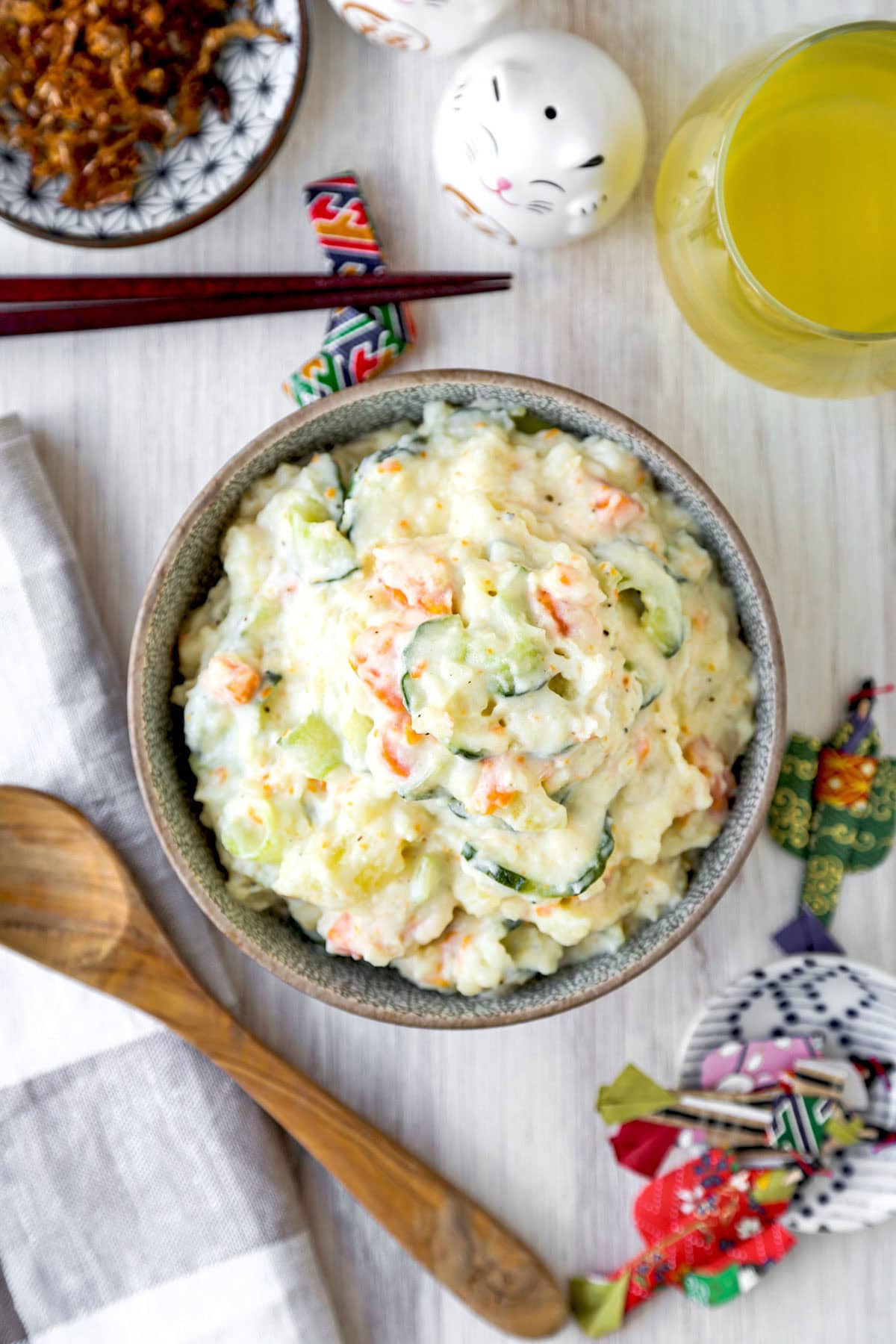
The first thing I noticed about Japanese potato salad when I was a kid was that it perfectly straddled the balance of savory and sweet without going too far either way. Turns out the heart of the flavor comes down to the use of Japanese mayonnaise which has a more eggy, umami flavor than Western mayo. And the natural sweetness emanates from mashed carrots – and sweet, salty bits of texture from pickled cucumbers. This recipe today stems from my longtime love of creamy and chunky Japanese potato salad.
This is one of those Japanese recipes I inherited from my mom. She took her potato salad to every outdoor BBQ, Christmas dinner or Easter potluck we were ever invited to. When I was 18 and headed off to New York, I asked her to show me the recipe. She taught me how to quick-pickle the cucumber slices with just a little sugar and salt – and impressed upon me how important it was to leave half of the cooked potatoes and carrots only slightly mashed so there would still be some soft chunks. Other than her miso soup and her legendary tuna sandwich, this potato salad is the essence of my mom’s cooking.
Table of Contents
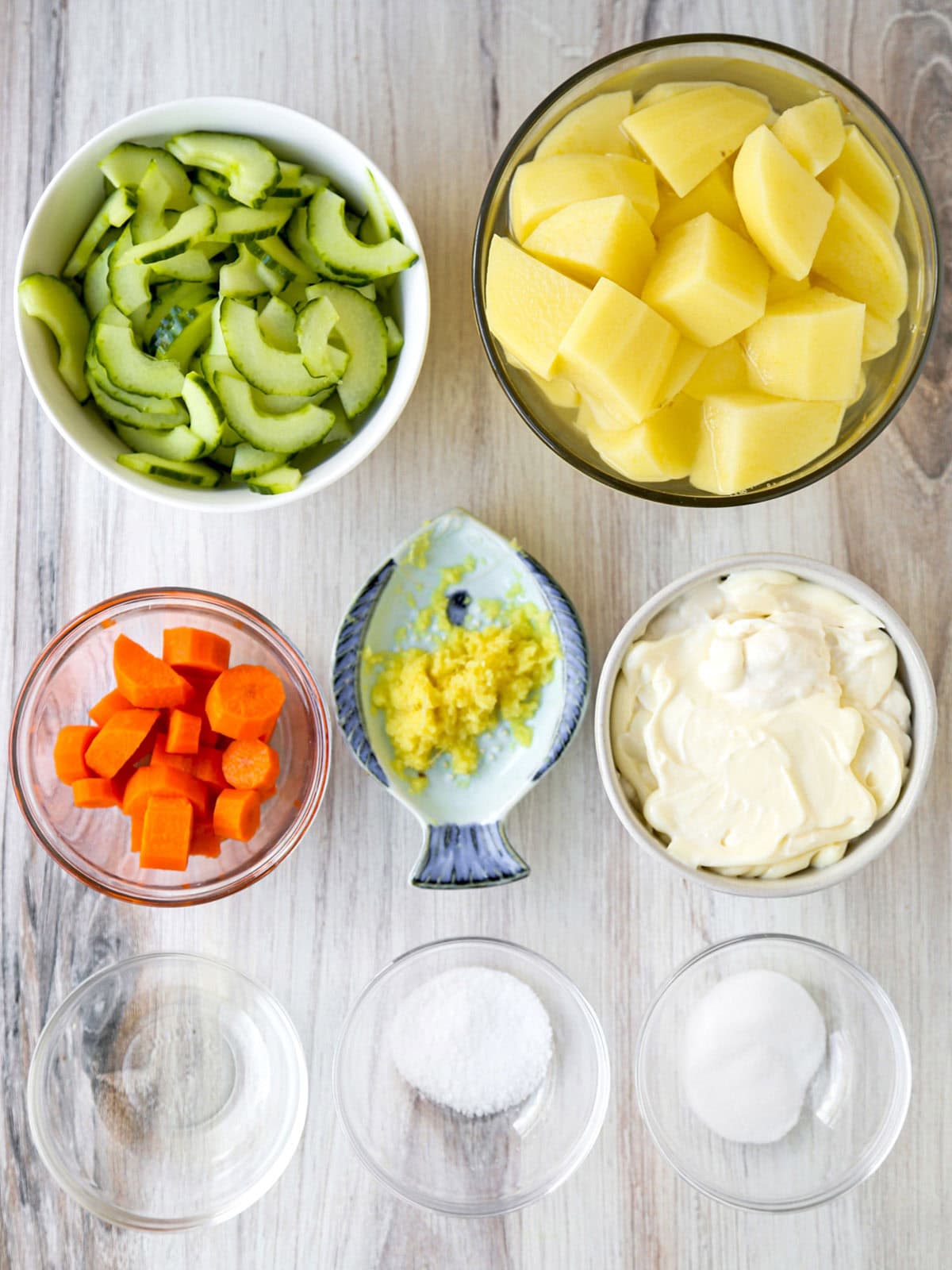
Ingredients
Scroll to the recipe card at the bottom of this page for the full recipe steps and measurements.
- Potatoes. I think Yukon Gold potatoes are the best in terms of taste (they are naturally sweet), and texture (they aren’t mealy once boiled). Russet potatoes will also do the trick in a pinch.
- Carrot. I add a roughly chopped carrot for color and sweetness. This is boiled and then partially mashed with the potatoes.
- Ginger. Fresh grated ginger infuses a slow burn without making the potato salad actually spicy.
- Cucumber. Get an English cucumber for this recipe (it’s perfectly crunchy). And use a Japanese mandolin slicer for uniform slices. I briefly pickle the cucumber with a little salt and sugar. Kirby cucumbers would work too.
- Mayonnaise. Use Japanese Kewpie mayonnaise for this recipe. It’s tangy, uamami, eggy and fruitier than regular mayonnaise. Or make homemade Japanese mayo instead of buying it. For a vegan potato salad, just use vegan mayo instead.
- Sake. Cooking sake adds a little sharpness.
- Sugar
- Salt
Variations
I actually stick to this recipe fairly closely, but here are a couple of easy additions to play with texture and flavor.
Make it crunchier. Add 2 tablespoons of chopped red onions – or 2 finely chopped green onions for sharpness and crunch.
Add a bit of heat. Most potato salad in Japan isn’t spicy at all aside from ginger’s slight burn. But I’ve added a bit of Japanese shichimi for a little kick before. And a sprinkle of Korean gochugaru adds a smoky heat.
Serve in a sandwich. Japanese potato salad sandwiches are a very popular snack at the konbini (convenience store). I make them all the time at home.
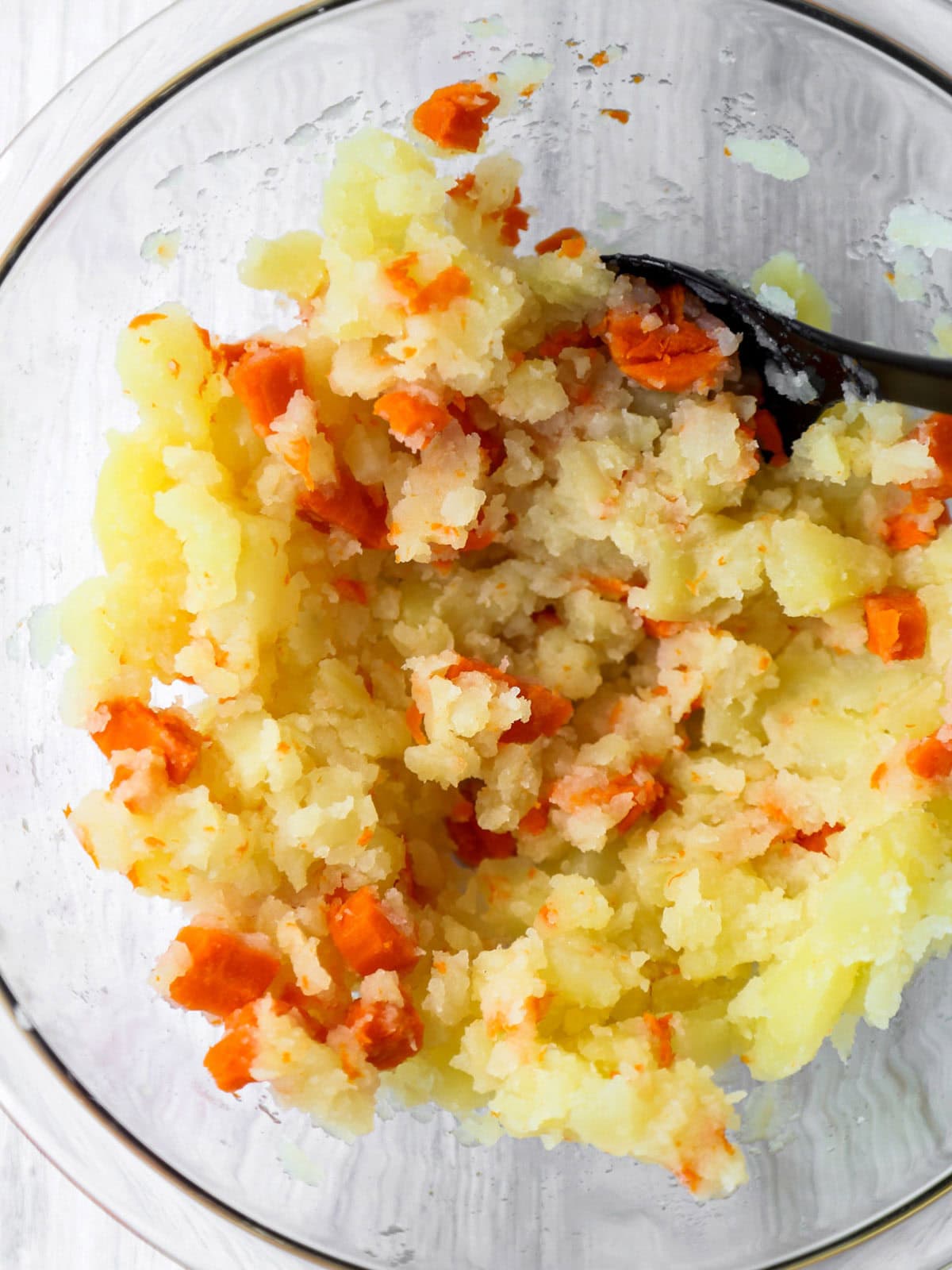
How to Make Japanese Potato Salad
- Boil the potatoes until tender (but not mushy). Drain and place in a mixing bowl.
- Boil the carrots until tender. Drain and add to the mixing bowl with the potatoes.
- Mash about half of the potatoes and carrots and stir together. Gently break the big chunks of potatoes with a fork or spoon. The texture you are looking for is creamy with small chunks that are easy to eat. Refrigerate for 20 minutes.
- De-seed, slice and pickle the cucumber with salt and sugar for 15 minutes. Then rinse, drain and squeeze away excess moisture.
- Season, mix and serve. Take the potato salad out of the fridge and stir in the mayonnaise, sake, ginger, salt, and sugar. Add the cucumber slices, stir well and serve.
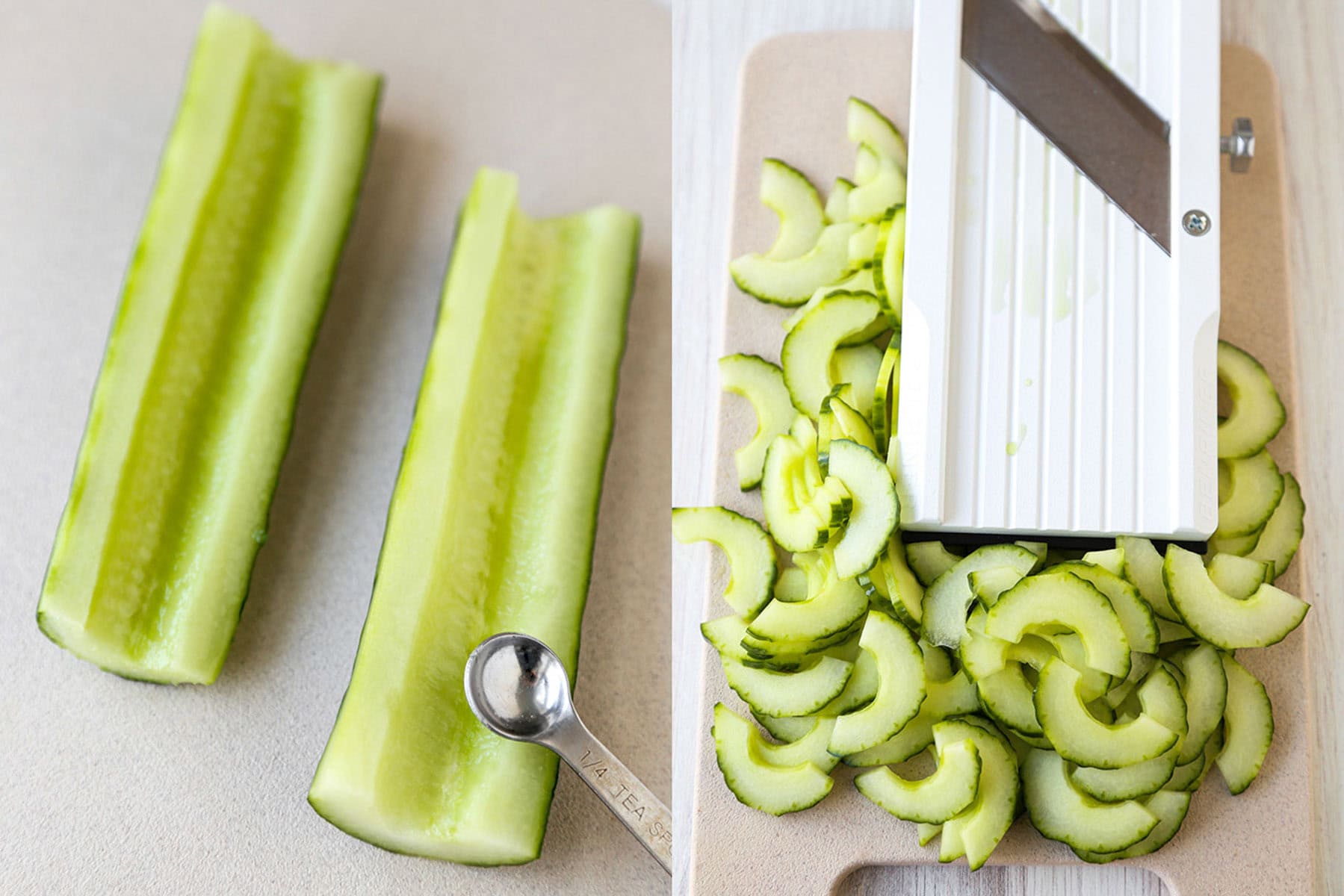
Expert Tips
Getting the cucumbers right is important in Japanese potato salad. Excess moisture is the enemy. Here’s how to minimize the moisture – while maximizing flavor and texture.
Minimize moisture by scooping out the cucumber seeds. English cucumbers have a thin vein of seeds running down the center. Slice the cucumber once lengthwise and scoop the seeds out with a spoon.
Quick-pickle with just sugar and salt. After deseeding and thinly slicing the cucumber, add a bit of sugar and kosher salt and let it rest for 15 minutes before rinsing the sugar and salt off through a colander.
Squeeze excess water from the rinsed cucumber slices before adding to the potato salad. Gently but firmly wring the water from cucumber slices with your hands. Strongly enough to eliminate most water – but not so hard that the pieces break. I blot mine with a paper towel afterwards.
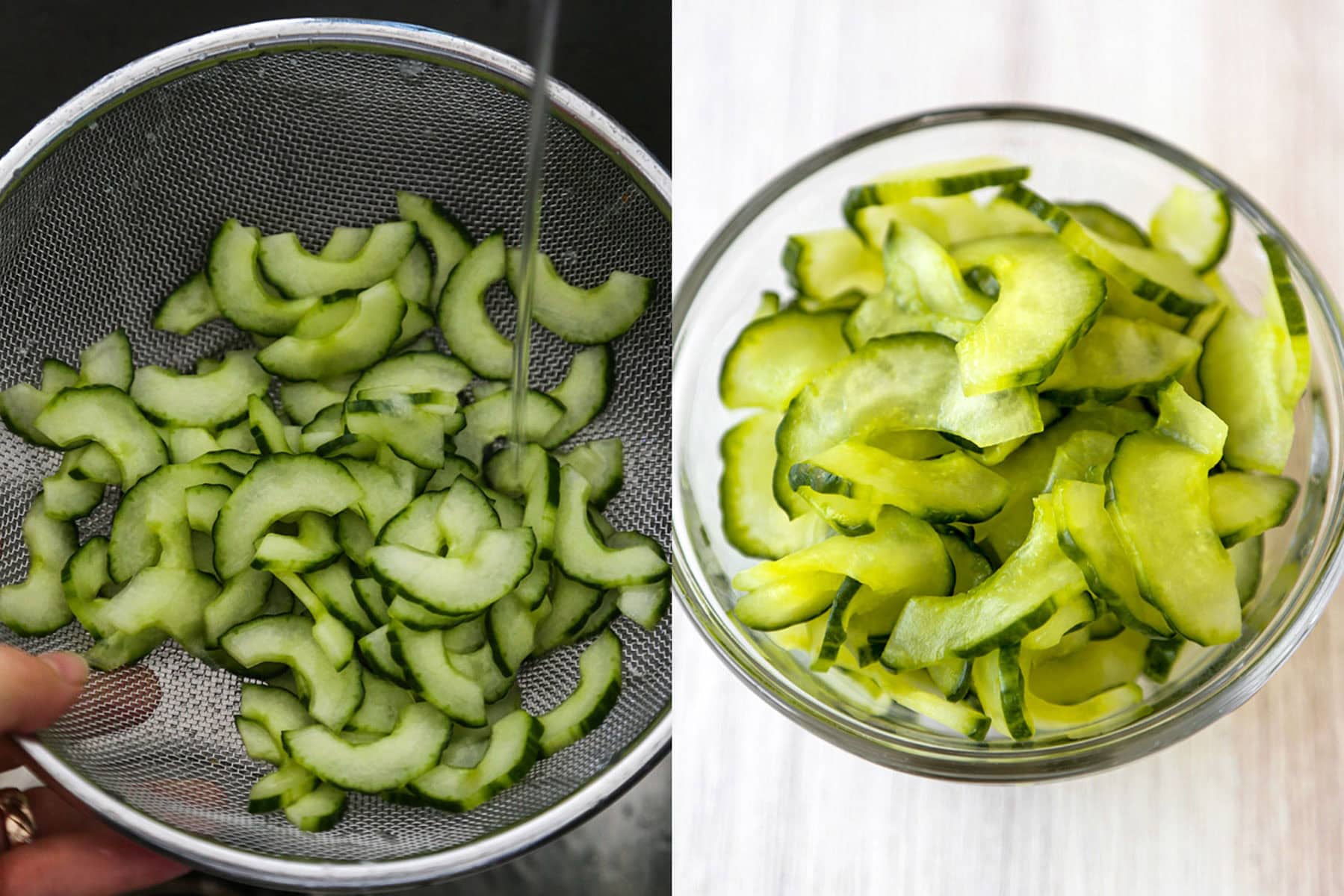
Storage
Store leftovers in a covered container in the refrigerator for up to 5 days. Since Japanese potato salad contains mayonnaise it must be kept in the fridge at all times.
I don’t recommend freezing leftover potato salad.
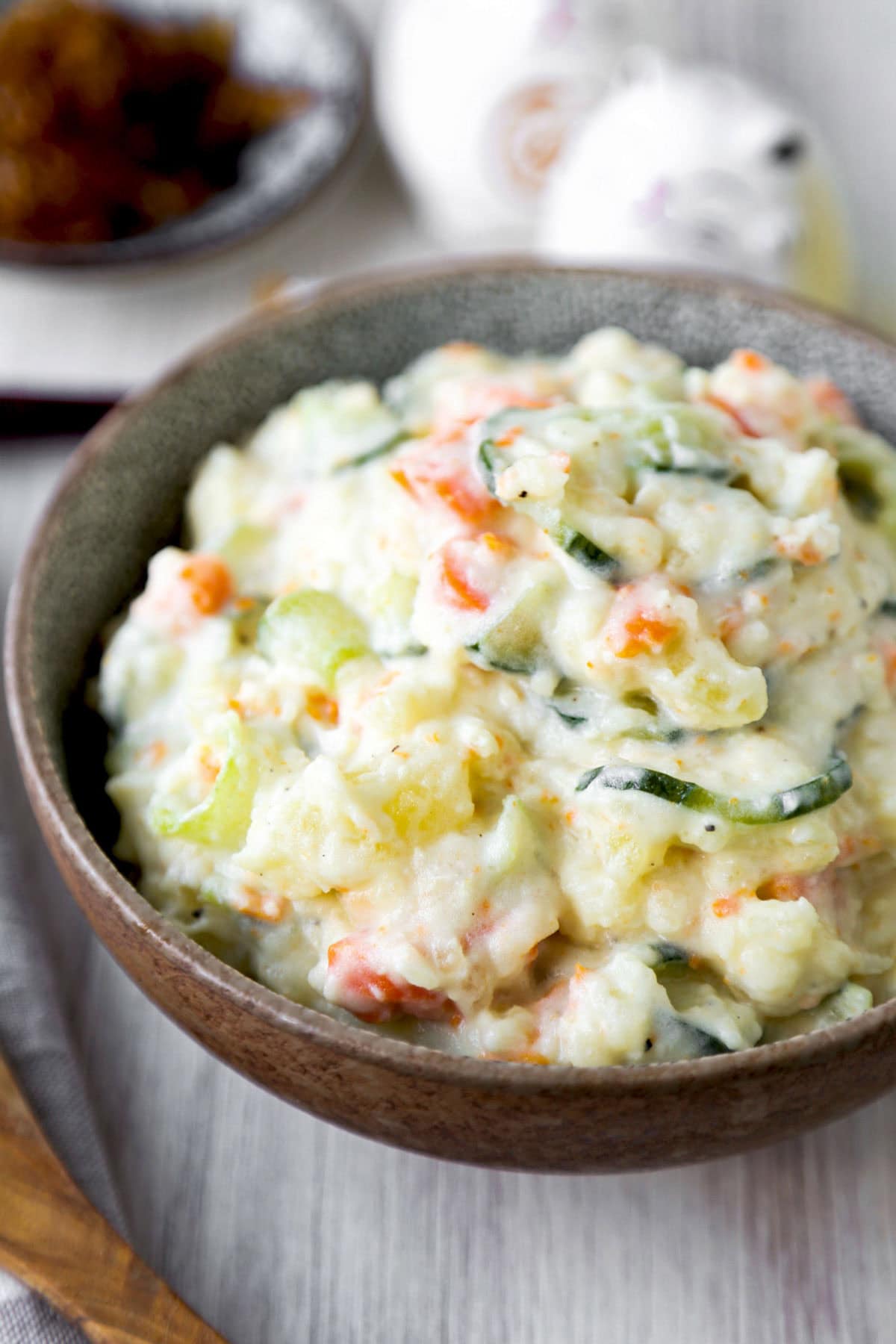
What I Serve With Japanese Potato Salad
The first time I hosted a backyard picnic with friends, I served my Japanese potato salad alongside a tray of tamago sando on Japanese milk bread – alongside crispy tempeh katsu sandwiches. Success! Some of my other favorites are:
- Japanese Coleslaw
- Osaka Style Okonomiyaki
- Baked Chicken Katsu
- Nasu Dengaku (Eggplant With Miso Glaze)
- Shiraae (Japanese Mashed Tofu Salad)
Other full flavor Japanese recipes: restaurant style Japanese carrot ginger dressing, kani salad, inari sushi, spicy tuna roll, chukadon, vegan gyudon, Japanese cream stew, mabo nasu, soba ankake, umeboshi sour, shaved carrot salad, konbini style tuna mayo onigiri
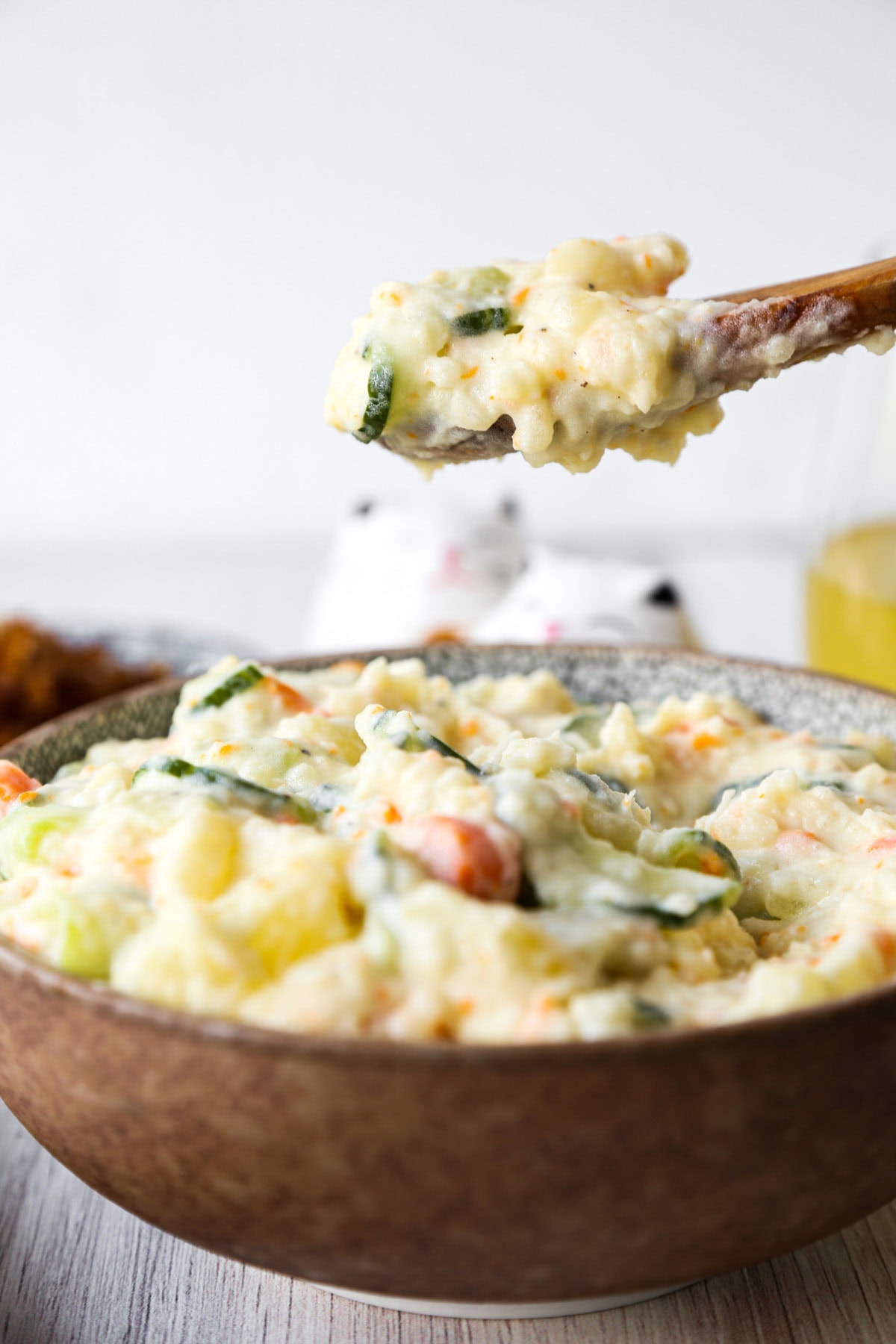
Frequently Asked Questions
Japanese potato salad is considered a yōshoku dish, which is a broad term for Western dishes prepared in a way that appeals to the Japanese flavor palate. While some flavors and cooking techniques have been appropriated from European and American recipes, they are then mixed with Japanese flavors. Just like poteto sarada, dishes like Japanese curry, spaghetti napolitan and hambagu are also considered yoshoku.
Great question! While it’s not the same, there are some similarities. Both Korean and Japanese potato salads typically feature a mix of potatoes, carrots, and cucumber, and are both seasoned with sugar and salt. However, Korean potato salad is actually much closer to the American version as it contains eggs, regular mayonnaise, and sometimes onions. The other main difference with most Korean versions is that the cucumber isn’t pickled like it is in the Japanese version.
Well, technically you can, but I stand firm on not recommending it. The things that happen to potato salad when it’s frozen aren’t very nice. The color of the salad changes and turns a faded grey, the texture of the potatoes may get mealy, and the salad becomes overall watery once thawed. Ew. If you would still like to freeze it, transfer the potato salad to a freezer bag and squeeze as much air out as you can. It will ‘keep’ for up to 3 months.
Did you like this recipe? Are there changes you made that you would like to share? Share your tips and recommendations in the comments section below!
Print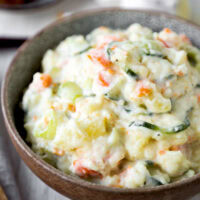
Japanese Potato Salad
- Prep Time: 15 minutes
- Cook Time: 10 minutes
- Total Time: 25 minutes
- Yield: 4 1x
- Category: Salads
- Method: Mixed
- Cuisine: Japanese
- Diet: Vegetarian
Description
Creamy, tangy, sweet and umami! I use thinly sliced pickled cucumber in my Japanese potato salad for zing and a lovely crunch.
Ingredients
- 2 medium to large potatoes, peeled and chopped bite size
- 1 medium carrot, peeled and chopped bite size
- 1/2 English cucumber, sliced in half lengthwise, center core with seeds removed with a small spoon
- 1 thumb size fresh ginger, peeled and grated
- 2/3 cup kewpie mayonnaise or regular mayonnaise, (or Vegenaise for vegan)
- 1 tablespoon sake
- 1 1/2 teaspoon granulated sugar
- 1 teaspoon kosher salt
Instructions
- Boil and drain the potatoes. Fill a small or medium pot with water and add the potatoes. Bring to a boil and cook for 5-6 minutes, until potatoes are tender but not mushy. Drain well and transfer them to a medium or large mixing bowl.
- Boil and drain the carrots. Bring another small pot of water to boil and add the carrots. Cook for 4-5 minutes, until carrots are tender. Drain well and add the carrots to the potatoes.
- Mash, mix and refrigerate. Using a potato masher or fork, mash half of the potatoes and carrots and mix. Break the remaining big chunks with a spoon or fork. The overall texture should be creamy with small bite size chunks. Refrigerate for 20 minutes.
- Slice and pickle the cucumber. Thinly slice the cucumber into 1/4-inch thick pieces (using a Japanese mandolin slicer or a chef’s knife) and add them to a bowl. Sprinkle 1/2 teaspoon sugar and 1/2 teaspoon salt over the cucumber slices and toss with your fingers to coat the pieces evenly. Leave for 15 minutes.
- Drain and blot the cucumbers. Drain the excess water through a colander and rinse under cold water. Drain and squeeze the excess water from the cucumber using your hands. Try to squeeze as much water as you can.
- Mix the potato salad and serve. Take the potato and carrot mixture out of the fridge and add the mayonnaise, ginger, sake, and the remaining sugar and salt. Mix with a spoon or spatula. Stir in the cucumber slices and mix well. Add more mayonnaise if needed. Serve.
Notes
Store leftover potato salad in an airtight storage container and refrigerate for up to 5 days.
Nutrition
- Serving Size: 4 servings
- Calories: 343
- Sugar: 4g
- Sodium: 843.4g
- Fat: 27.6g
- Saturated Fat: 4.3g
- Unsaturated Fat: 16.5g
- Trans Fat: 0g
- Carbohydrates: 20.9g
- Fiber: 3.1g
- Protein: 2.4g
- Cholesterol: 15.4mg
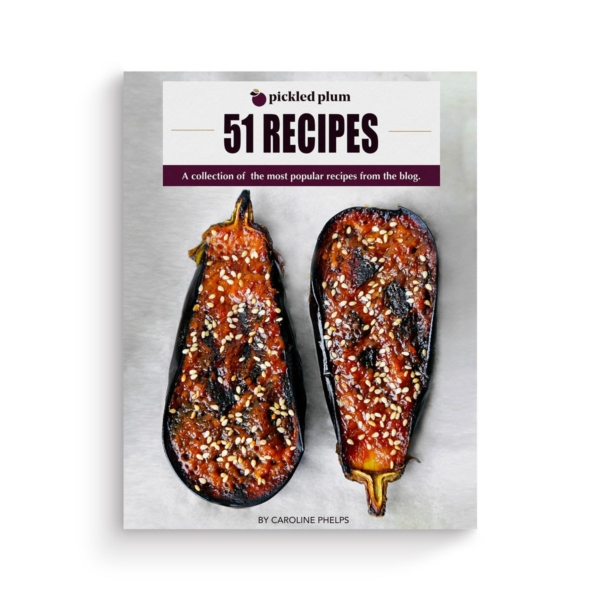

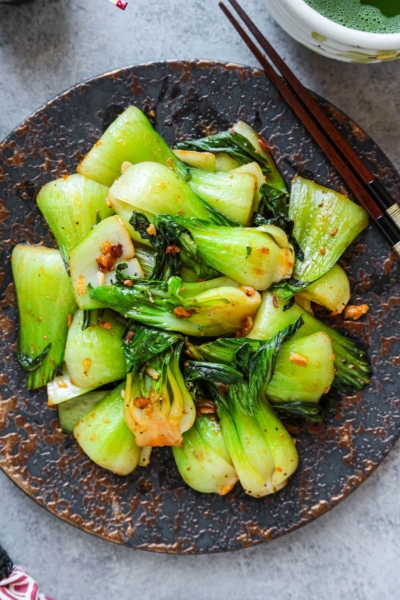












Loved this recipe. Made pretty much exactly as directed. Added two small green onions and two small foraged garlic chives. Love the sweet and tangy flavors. Will def make again!
Great salad. I thought the sake and so much ginger would throw it off, but it has a nice delicate flavor and I was pleasantly impressed. I will be making this for an Asian themed dinner for our family reunion. Thanks so much for this recipe.
I absolutely love this recipe. It’s so good, yet healthy.
Thanks For Sharing this Amazing Recipe. My Family Loved It. I will be sharing this Recipe with my Friends. Hope They will like it.
Your recipe says add 1:2 tsp sugar and 1/2 tsp sugar to the cucumbers. What is it supposed to say?
Hi Bunnie, it’s 1/2 teaspoon sugar (not 1:2 tsp). Could you tell me what browser you are using, I’m seeing 1/2 teaspoon from my end. I’m wondering if it’s displaying differently on different browsers… Thank you!